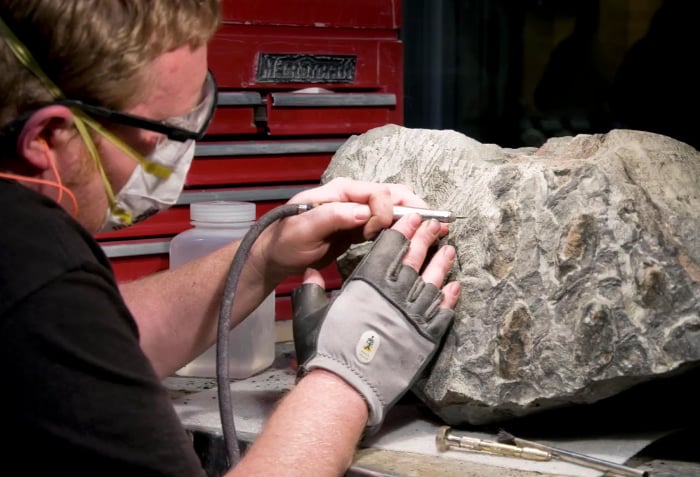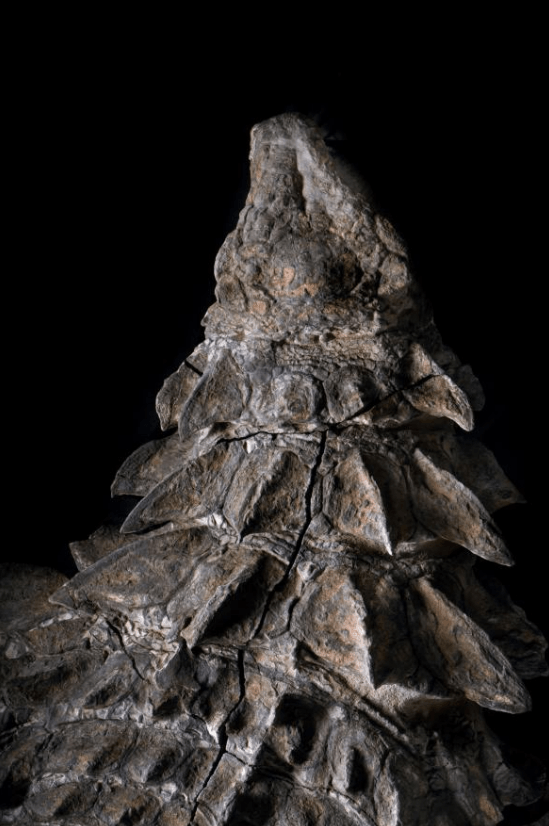Mummy Dinosaur Discovered With Skin and Guts Intact
According to scientists, this dinosaur specimen may be the best preserved dinosaur specimen ever discovered. Miraculously, the bones are still covered by skin and armor, 100 million years after the creature’s death.
A discovery like this is obviously incredibly rare and coveted by scientists world-wide. Read on to see the incredible photos of Nodosaur, the dinosaur mummy.
An Incredible Accidental Discovery
In March 2011, while working at the Millennium Mine in Alberta, a miner named Shawn Funk noticed something strange. When his excavator struck a rock, he noticed something that appeared to be a fossil. The discovery was quickly reported to the Royal Tyrrell Museum of Paleontology, who identified the specimen as an ankylosaurian dinosaur.

Smithsonian Channel
Over a period of 14 days, the miners worked to recover the fossil. During the process, a rock containing the fossil broke into several pieces. The pieces were stabilized in plaster and brought to the museum.
Repairing the Damaged Fossil
It took six years to fully restore the damaged fossil so that it could be studied. The restoration was handled by a technician named Mark Mitchell. To honor his work, the species, B. markmitchelli, was named after him.

The Royal Tyrell Museum
During the restoration process, it became clear that this fossil was a one-in-a-million discovery. Not only was it a new species, but the fossil had intact skin and armor. Since the fossil was so well-preserved, it was possible to see what the dinosaur was like when it was still alive.
The Nodosaur, a Mummified Dinosaur
The specimen was a nodosaur, a massive herbivore that walked on four legs and was protected by spiky armor. When it was alive, it weighed about 3,000 pounds. The nodosaur fossil that was discovered is almost completely intact and weighs around 2,500 pounds.

National Geographic
This fossil is the best-preserved specimen of its kind. Experts believe that the fossil is in such great condition because the dinosaur was on the ocean floor for millions of years. This allowed the specimen to be preserved with minimal distortion, like a mummified dinosaur.
Preserved In 3D
Only the front half of the nodosaur was preserved in 3D. Experts believe that this is because the dinosaur was front heavy. When the dinosaur sank into the water, the top half of the dinosaur was partially buried in the sediments on the ocean floor.

This process allowed the dinosaur’s actual tissue to be replaced with mineral, giving it its three-dimensional appearance. Even though only part of the dinosaur was preserved in this way, it’s still considered to be one of the best preserved fossils of all time.
A Dinosaur With Amazing Armor
While this particular specimen was 18 feet long, researchers believe that the nodosaurus could grow up to 20 feet. The dinosaur was covered in heavy armor, which helped to protect it from many predators. Even dinosaurs with sharp teeth couldn’t penetrate its bony plates.

Smithsonian Magazine
In addition to its armor, the nodosaurus had a bony tail that it could use to fight off predators. While this protection kept the dinosaur safe from many carnivores, it was still threatened by some predators. Thankfully, the dinosaur had protection that went beyond its armor.
How the Nodosaur Hid from Predators
The excellent condition of the nodosaur specimen allowed researcher to see what the dinosaur would have looked like millions of years ago. Mass spectrometry techniques even made it possible to see pigments on the dinosaur’s scales. It’s believed that the dinosaur was a deep reddish-brown color, with lighter scales on its underside.

The Guardian
The nodosaur’s heavy armor gave it plenty of protection, but researchers believe that its two-toned scales also helped it camouflage itself from predators. Since the nodosaur was 18 feet long, its predators must have been much larger.
Inside the Nodosaur
When the nodosaur specimen was preserved, the contents of its stomach were preserved as well. The dinosaur’s stomach, which is about the same size of a basketball, mostly contains the soft leaves of ferns. Its stomach also contains microfossils of pollen, spores, and flowering plants.

Royal Tyrell Museum of Paleontology
Since many other plants would have been around during that time, researchers believe that the dinosaur must have had a strong preference for ferns. In fact, it even appears that the nodosaur limited itself to munching on specific types of ferns.
What These Plants Can Tell Us
Inspecting the contents of the nodosaur’s stomach tells us what the dinosaur liked to eat, but it also gives us information about when this particular specimen may have died. Based on the growth rings of the plants, it’s believed that this dinosaur died in the spring and summer.

The Royal Tyrell Museum
In addition to plants, the dinosaur has charcoal inside its stomach, which suggests it was in an area that had been razed by wildfires. Forest fires were very common during the early cretaceous period, which was when the nodosaur lived.
An Incomplete Picture
While this spectacular specimen can teach us a lot about the nodosaur, it’s important to remember that it can’t tell us everything. It’s possible that the chemistry of the fossil may have over millions of years, which means the fossil we’re seeing differs from the nodosaurs that once walked the earth.

National Geographic
Researchers will continue to examine the specimen to see what else they can learn. If other specimens of this species are found, those fossils may provide us with more information as well, even if they’re less well-preserved than this fossil.
